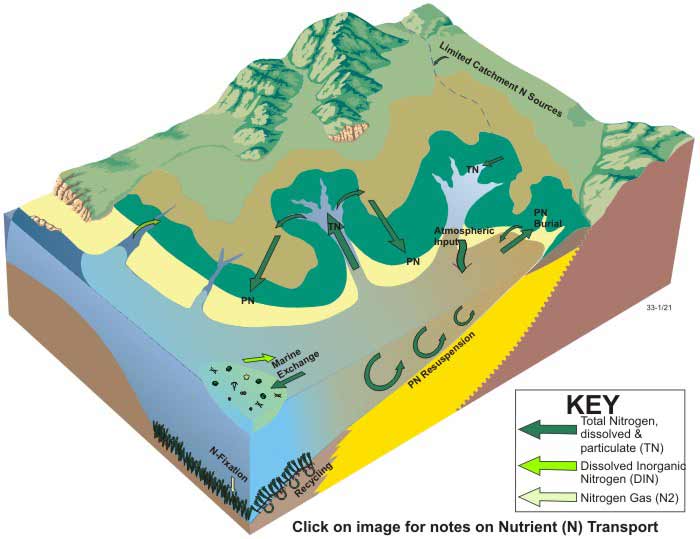
Nitrogen dynamic processes in tidal creeks
1. Catchment derived sources of nitrogen
Catchment-derived sources of nitrogen are less important in tidal creeks – significant input typically occurs during extreme rainfall events only (Harris, 2001).
2. Transportation of particulate nitrogen
Large tidal movements on the flanks of the tidal creek transport particulate nitrogen (PN) and dissolved inorganic nitrogen (DIN) onto the sediments of the intertidal flats (Alongi et al., 1999), where some of the dissolved inorganic nitrogen (DIN) is converted to particulate nitrogen (PN) through the activity of benthic micro-algae and other sediment-dwelling organisms.
3. Mangrove sediment
Mangrove sediment is a net sink for dissolved inorganic nitrogen (DIN) and (PN) particulate nitrogen (Alongi, 1996). Nutrient uptake is driven by high rates of plant productivity and microbial activity. N-fixation (incorporation of atmospheric N2 to form nitrogenous organic compounds) is active in the root-zone and contributes to the dissolved inorganic nitrogen (DIN) pool (Kristensen et al., 1998). Some N is liberated to the atmosphere as N2 gas through denitrification (Rivera-Monroy et al., 1996, Trott et al., 2000). Particulate nitrogen (PN) is typically processed by sediment-dwelling biota such as crabs, or is exported to the coastal waters in the form of leaf litter and fine particulate matter (Ayukai et al., 1998). This material is redistributed during ebb tides and may be exported from the tidal creek.
4. King tide effects
Small amounts of particulate nitrogen (PN) are buried in saltflats during king tides. Most particulate nitrogen (PN) is exported back into the channel during the ebb tide (Ridd et al., 1988).
5. Particulate nitrogen (PN) and dissolved inorganic nitrogen (DIN)
Particulate nitrogen (PN) and dissolved inorganic nitrogen (DIN) exist within the water column. However due to turbidity and low light penetration, phytoplankton productivity is limited (Cloern, 1987, Monbet, 1992). Circulation and re-suspension of particulate nitrogen (PN) occurs in this zone. Particulate nitrogen (PN) is probably reworked during the resuspension process, and dissolved inorganic nitrogen (DIN) can be released into the water column through the process of remineralisation.
6. Uptake of nitrogen by marine phytoplankton
A proportion of the total nitrogen (TN) load escapes through the mouth of the tidal creek into the marine environment. Assimilation of nutrients by phytoplankton in the marine environment is typical, as turbidity levels become lower in the marine environment.
7. Nitrogen exchange in marine waters
Typically, only small quantities of the catchment-derived total nitrogen (TN) load is exchanged with the marine environment, due to efficient trapping and processing by intertidal vegetation. Export is more significant during extreme runoff events.


